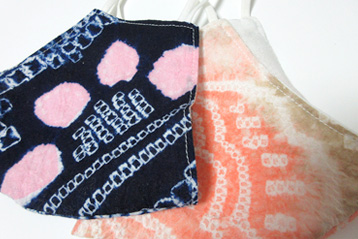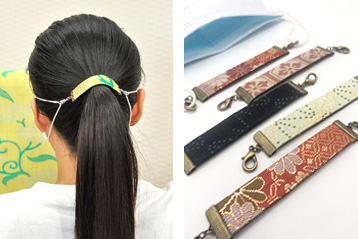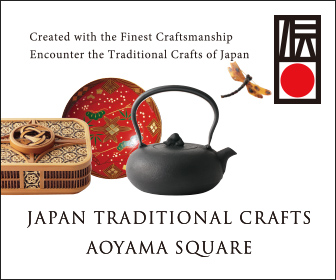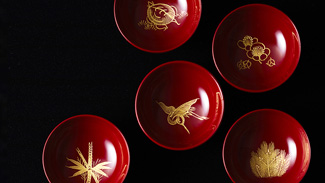TEXTILES
FASHION STATEMENTS BEING MADE WITH MASKS

The year 2020 has been eventful, to put it mildly. While it would be difficult to pick one symbol that sums up everything that has happened, it is not hard to imagine that mask-covered faces will be the enduring image of 2020.
The most common choice remains a disposable surgical mask, though people are starting to pick masks to suit their personal style in the same way they choose T-shirts and sneakers.
Face coverings made with traditional Japanese designs and materials are now available and create opportunities for people to come into contact with fabrics and patterns that are usually found only in kimonos and yukata (lightweight summer kimonos).
Indeed, no one in the fashion industry would have predicted that one of its major challenges this year would be adapting a medical product to everyday use. Even in Japan, where masks were relatively common before the pandemic, there had been little innovation in styles or materials.
Yet, their evolution has been rapid. When supplies of disposable masks ran short, companies began making washable versions that could be used repeatedly. Initially, these masks were mostly available in white, black if one wanted to be edgy.
The next step was improvements in the quality and variety of materials and designs. Masks are now available in a dazzling array of options. A person can choose a paper mask for a trip to the grocery store, a flashy design for going out with friends and one made by a luxury brand for a formal setting.

While kimono and yukata are no longer worn in most arenas of everyday life, traditional Japanese fabrics and designs remain a popular choice for accessories. Many makers of traditional products saw an opportunity in 2020’s most significant new fashion item.
It was not immediately obvious that masks made out of kimono fabric would be popular. The story of Suehiro-ya, a third-generation kimono shop in Ota Ward, Tokyo, highlights this.
According to Mitsuyo Tsuji, whose husband is the proprietor of Suehiro-ya, most of their customers are tea ceremony aficionados. When the pandemic shut down indoor social activity, the shop saw sales plummet and customer numbers dwindle.
With time on her hands, Tsuji grabbed some kimono fabric and sewed herself a couple of masks. When admiring friends and family asked her to make them masks as well, she thought she might be onto something that could sell even during a pandemic.
Suehiro-ya now sells a wide selection of masks. During the summer, many were made from yukata material. Now that winter is here, most are dyed silk. The summer masks’ designs were often created using Arimatsu shibori, a painstaking method of tie-dyeing that can create intricate patterns, traditionally in indigo and white. All kinds of kimono material are used for the silk masks, including luxurious Oshima tsumugi fabric from the Amami Islands in Kagoshima Prefecture.
Tsuji said the masks have brought a new stratum of customer to her store, including people who typically would have never entered Suehiro-ya because they thought kimono and tea ceremony were all too stuffy.
The new customers include several non-Japanese residents of the area. A few bought multiple masks, probably to send home to friends and family, she thinks. If rarity is luxury in fashion, with most borders still closed, surely a Japanese silk mask could be seen as a status symbol in many countries.
Yet, in certain situations, one might prefer the relative anonymity of a regular paper mask over making an individual statement with a unique design.
Instead of creating her own masks, Mayu Tomita — the designer behind aturae, a Kyoto-based maker of accessories and clothing with traditional designs — came up with a line of holders that clip onto a mask’s ear straps to hold it in place.

When attached, the holder sits at the back of the head and looks something like a hair barrette. A bonus is that it takes pressure off the ears, which can become chafed when a mask has to be worn for hours at a time. People with eczema and other skin conditions can find masks particularly uncomfortable due to the tight ear straps.
The holders are made from Nishijin ori and other high-grade silk kimono fabrics and come in a variety of flower and geometric patterns. In Nishijin ori, the designs are woven rather than dyed. The subtle elevation created by the weaving gives this kind of fabric a more weighty look and feel, making them an appropriate choice for more formal situations. The holders come in numerous colors and designs that can be selected based on the setting or the wearer’s outfit.
Tomita’s father is the well-known kimono designer and stylist Nobuaki Tomita, whose outfits have appeared on television, in movies and magazines in Japan, as well as at kimono events held overseas. aturae products can be found on the brand’s eponymous website. Questions about overseas shipping should be directed there.
(https://www.aturae.jp/)
It may not be practical (or economical) to purchase multiple high-end masks in different colors, but a few mask holders provide flexibility in a way that will not break the bank. After the pandemic ends, these holders can perhaps be put to some other use, as they do not necessarily need to be attached to the ear straps of a mask.
The market for traditional crafts has been in long decline as people opt for modern styles while methods of mass-production also flood shelves with cheaper products. Yet few would deny the quality and appeal of these cultural treasures, which is especially true of kimono fabric.
Hopefully, masks will not need to be an integral part of daily life for much longer. Still, the popularity of face coverings made with traditional designs and fabrics shows that with a little ingenuity, there are still ways these items can be a part of our lives.













